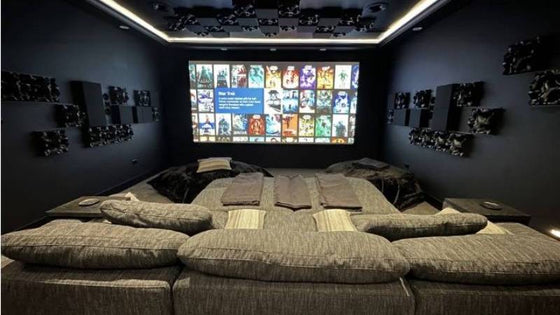Creating a system you love shouldn't be difficult. The Acoustic Frontiers blog is here to help.
Some unavoidable facts:
If are unhappy with the performance of your home theater, listening room or recording studio in the bass and lower midrange frequencies then it is highly likely that the problem is related to the negative impact of modal resonances. You will need to learn a little about the science behind room modes to understand how to reduce or remove their impact on sound quality.
Room modes are created when a sound wave travels between two opposite boundaries, for example the left and right side walls or the floor and ceiling. The first modal resonance occurs at the frequency where the distance between the two boundaries is equal to half a wavelength. If a room is 18ft long then the first modal resonance will be at 31Hz. There are further resonances at multiples of this frequency. There is a huge amount of good information available on the web about room modes so I won’t try and replicate it here. Read some of the following links:

A screen capture of the awesome animation over at the ISVR page
Whilst learning about room modes, you will almost certainly run into ‘Room Mode Calculators’. These predict the frequencies at which modal resonances will occur. For rectangular spaces room modes can be easily predicted from the length, wide and height dimensions.
If you have a non-rectangular or odd shaped room (e.g. L-shaped or open plan) then I would recommend skipping calculators completely and going straight to measurement, or hiring a professional with the capability to do the right modeling. Predicting the room modes in such a space is a non-trivial exercise – we use boundary element modeling (BEM).
Using the results produced by a calculator it is possible to see which peaks on a frequency response measurement are room mode related and which are caused by other mechanisms such as speaker boundary interference. Check out a couple of these links:

The Harman Room Mode Calculator
It is important not to get too hung up on the results of the room mode calculator since it does not tell you the impact of modal resonances IN YOUR ROOM.
The first reason is that a room mode calculator does not show you the effect of modal resonances on the frequency response or time domain performance of your system. Two rooms with the same dimensions can have very different performances due to the materials used in the construction of the room and the furnishings used.
The second reason is that in real life the actual room modes can be greatly affected by walls with doors, windows and other departures from the infinitely stiff surface used in the math that the calculators use. Therefore it is important to measure your room to identify what modal resonances issues there are and have a reference point to compare with once you have implemented some improvements.
Evidence of resonances can be seen in three areas in our measurements:
Clear evidence of room modal activity can be seen in this high resolution frequency response plot taken with XTZ Room Analyzer II Pro. You can get similar plots from software like Room EQ Wizard and Omnimic as well as the old school graph paper, test tones and SPL meter. For more on acoustic measurement options see our blog article: four approaches to room acoustic measurement.

Frequency response, as taken with XTZ Room Analyzer II Pro
This 2D waterfall or cumulative spectral decay plot (CSD), taken with Room EQ Wizard, clearly shows evidence of modal resonances, identifiable by their slow decay in the time dimension.

Room EQ Wizard Spectrogram
Room modes can be identified through peaks in the frequency response and slow decay in the time domain. We made a video showing how to interpret the acoustic measurements and spot room modes. This video shows XTZ Room Analyzer II Pro but you can use a similar technique for other measurement solutions.
There are a number of different solutions to room mode issues.
Learn how early home theater design, layout, and acoustic treatment improve performance in new home construction.
This media room was intentionally designed to feel like part of the home—not a separate, tech-heavy space. Through careful acoustic planning, equipment integration, and final calibration, we achieved a room that is both beautiful to live in and immersive to experience.
"No other subwoofer system I’ve owned even comes close to what this room delivers. Reaching out to Acoustic Frontiers was one of the best decisions I’ve made—I highly recommend working with them if you want to get the most out of your theater."

Nyal Mellor, Founder, Acoustic Frontiers



Nyal Mellor
Author